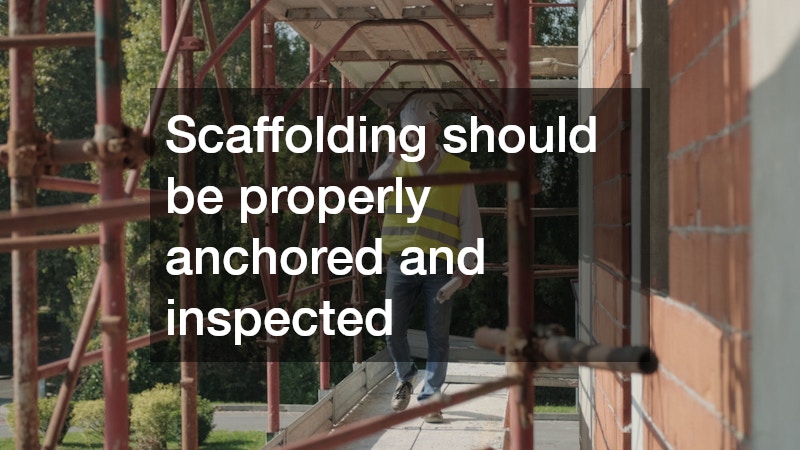-
Always plan renovations with safety in mind — start with structural assessments, proper permits, and licensed professionals.
-
Prepare the site carefully by clearing clutter, securing utilities, and ensuring solid ground for equipment setup.
-
Use crane services for heavy lifting when handling large or heavy materials to reduce manual strain and prevent property damage.
-
Communicate clearly with contractors, establish safety zones, and hold regular safety check-ins.
-
Protect workers and homeowners with proper safety gear, reinforced structures, and organized waste handling.
-
Schedule final inspections and cleanup after construction to ensure the home remains safe and hazard-free.
-
Investing in professional help and equipment upfront prevents costly accidents and ensures long-term home safety.

Major home renovations can transform your property — whether you’re adding a second story, remodeling your kitchen, or installing a prefab structure in your backyard. But with all the excitement comes significant risk. Accidents involving falls, collapsing structures, and heavy materials are far too common in large-scale remodels.
Homeowners often underestimate just how complex and dangerous major renovations can be. From demolition work and power tool use to heavy lifting and debris disposal, every stage has its hazards. That’s why professional planning and the right equipment — including crane services for heavy lifting — play such a vital role in ensuring a safe and efficient renovation.
This guide explains how to make your home renovation safer at every step, from pre-project planning to post-construction cleanup.
Understanding the Risks of Major Renovations
Before any work begins, it’s important to understand what makes large home renovations risky. Many hazards arise not from carelessness but from a lack of preparation or improper tools. Even experienced DIYers can get hurt when lifting or handling materials that exceed their safe weight limits.
Common risks during renovation include:
-
Falls from heights: Working on roofs or second-story framing increases the risk of falls, especially when using unstable ladders or makeshift scaffolding.
-
Structural instability: Removing load-bearing walls without support or lifting heavy materials without balance can lead to partial collapses.
-
Electrical and gas hazards: Cutting into hidden wiring or gas lines during demolition can cause fires or explosions.
-
Improper lifting techniques: Manually lifting items like beams, bathtubs, or HVAC units can lead to back injuries or dropped materials.
-
Dust and chemical exposure: Older homes may contain asbestos, lead paint, or harmful particulates that can affect indoor air quality.
For projects involving heavy loads — such as installing trusses, hot tubs, or large prefabricated panels — professional crane services for heavy lifting are the safest option. They eliminate manual strain and minimize the risk of damage or injury.
Start with a Safe and Smart Plan
Safety begins long before the first wall comes down. A detailed plan keeps the renovation organized, ensures compliance with local codes, and reduces costly surprises.
When developing your renovation plan:
-
Assess the structure: Hire a structural engineer to inspect your home before demolition. They can identify weak areas, load-bearing walls, and safe lifting points.
-
Secure the proper permits: Local building departments often require permits for heavy lifting or structural work. Unpermitted renovations can lead to fines and insurance issues.
-
Hire qualified professionals: Use licensed contractors and certified crane operators. A professional team understands the logistics of safe lifting and can coordinate tasks to prevent on-site accidents.
-
Plan the sequence of work: Schedule demolition, delivery, and lifting tasks logically. For example, lifting heavy roof panels should happen before finishing interior drywall to prevent unnecessary rework or risk.
A good plan should also include risk assessments and contingency measures. Know how your contractor will handle emergencies such as weather delays, mechanical failures, or unstable structures.

Safe Site Preparation Before Renovation
Before work begins, the site should be properly prepared to prevent hazards. Many accidents occur simply because tools, debris, or vehicles clutter the workspace.
Preparation checklist for homeowners:
-
Clear the area: Move out furniture, electronics, and valuables. Ensure there’s a clear path for workers and machinery.
-
Protect non-work zones: Seal off adjacent rooms with plastic sheeting to contain dust and debris.
-
Check accessibility: Make sure cranes, trucks, and lifting equipment can access the property without damaging landscaping or driveways.
-
Establish safety zones: Mark off exclusion areas where family members or pets are not allowed.
-
Ensure stable ground: If you’re hiring crane services for heavy lifting, verify that the setup area is solid, level, and capable of supporting the crane’s load.
Even small details like removing overhanging tree branches or securing loose soil can make a big difference when heavy machinery is involved.
Protecting Your Home’s Structure and Utilities
Renovations that alter your home’s structure or utilities require extra care. Before any cutting or lifting, know where all plumbing, gas, and electrical lines are located.
Safety measures to protect your home:
-
Turn off utilities before demolition: This prevents accidental fires, flooding, or electrical shocks.
-
Support weakened structures: Use temporary beams or jacks before removing load-bearing components.
-
Consult an engineer before heavy lifts: Lifting a new beam or prefab module can change your home’s load distribution. A professional can calculate safe lift points.
-
Use proper lifting tools: For large or awkward loads, rely on hoists, pulleys, or crane services for heavy lifting to keep materials stable during placement.
Proper reinforcement ensures that both your existing home and any new additions remain structurally sound throughout construction.
Safety Gear, Tools, and Equipment
Even with professionals on-site, having the right gear and tools matters. Each piece of equipment should be maintained, certified, and used correctly.
Essential safety gear includes:
-
Hard hats, gloves, and steel-toed boots
-
Safety glasses or face shields to protect against flying debris
-
Respirators or masks when working in dusty environments
-
Ear protection when using loud machinery
For heavy lifting and large materials:
-
Use crane services for heavy lifting instead of manual or makeshift methods.
-
Scaffolding should be properly anchored and inspected daily.
-
Power tools must have safety guards and be used with proper grounding.
Never compromise safety by skipping gear or using worn-out equipment — even on smaller tasks.

Working Safely with Contractors and Crews
A safe renovation depends on strong communication between homeowners, contractors, and any third-party operators.
Tips for working with your renovation team:
-
Verify licenses and insurance: Every contractor and crane operator should be fully certified and insured for residential work.
-
Hold daily or weekly safety check-ins: Brief the crew on site hazards, lifting plans, and any changes in the work schedule.
-
Designate a safety supervisor: Have someone on-site responsible for ensuring protocols are followed.
-
Coordinate with crane services early: Discuss lifting routes, timing, and setup requirements before equipment arrives.
Homeowners should avoid entering active work zones unless necessary. Let professionals handle tasks involving machinery, scaffolding, or electrical systems.
Safe Handling of Materials and Waste
Proper material management keeps the site cleaner, safer, and more efficient.
To handle materials safely:
-
Organize storage areas: Keep heavy or bulky materials in stable stacks, away from walkways.
-
Label hazardous substances: Paints, adhesives, and sealants should be sealed and stored away from heat sources.
-
Use mechanical aids: Use carts, dollies, or forklifts instead of carrying heavy items manually.
-
Dispose of waste properly: Rent a dumpster for construction debris and use covers to prevent wind-blown materials.
For oversized waste — like concrete slabs or steel beams — crane services for heavy lifting can remove them safely without damaging the property or endangering workers.
Managing Heavy Equipment and Lifting Tasks Safely
One of the most dangerous parts of any renovation is lifting and placing large materials. Even lifting something slightly off-balance can cause serious injury or damage. That’s where crane services for heavy lifting play a crucial role.
When to hire crane services:
-
Installing roof trusses, solar panels, or air conditioning units on upper levels
-
Placing prefabricated modules or tiny homes on foundations
-
Lifting large landscaping elements like trees, boulders, or outdoor spas
-
Transporting construction materials to hard-to-reach locations
How professional crane services improve safety:
-
Precision and control: Modern cranes have load sensors, remote operation, and stabilizers to ensure perfect balance.
-
Reduced labor strain: Workers don’t need to manually lift or guide heavy items, minimizing the risk of injury.
-
Site efficiency: Lifts can be completed in hours instead of days with manual labor.
-
Compliance with safety standards: Certified operators follow strict guidelines for setup, operation, and rigging.
Before hiring, ask about the company’s experience with residential projects, their insurance coverage, and whether they perform site assessments beforehand. A reputable provider will also offer guidance on ground preparation and clearance requirements.
Maintaining Safety After Construction
Even when the renovation is complete, some risks remain until the area is fully inspected and cleaned.
Post-construction safety steps:
-
Schedule a final inspection: Ensure electrical systems, plumbing, and load-bearing structures meet code.
-
Clean thoroughly: Remove dust, leftover debris, and sharp objects. HEPA vacuuming helps restore air quality.
-
Check for hidden hazards: Look for exposed nails, sharp edges, or unsealed areas that could cause injury.
-
Test systems: Run HVAC units, test outlets, and check water lines for leaks or blockages.
A clean and inspected renovation site is not just about appearances — it ensures your new living space is safe and functional for years to come.

Cost Considerations for Safe Renovations
Safety measures and professional lifting services come at a cost, but they’re far more affordable than the potential damage or injuries caused by unsafe work.
Typical safety-related expenses include:
-
Hiring licensed contractors and engineers
-
Renting scaffolding, harnesses, or temporary supports
-
Using crane services for heavy lifting when required
-
Site inspections and building permits
-
Waste disposal and post-renovation cleanup
While DIY methods may seem cheaper, professional-grade safety and lifting equipment ensure long-term savings by preventing costly structural damage or medical bills.
The Role of Insurance and Permits
Many homeowners overlook the importance of having the right insurance and permits during renovation. Without them, you could be held liable for accidents or property damage.
Before starting work:
-
Verify that your homeowner’s insurance covers renovation-related incidents.
-
Ensure all contractors carry liability and worker’s compensation coverage.
-
Obtain required building and crane operation permits through local authorities.
This paperwork protects both you and the workers in case something goes wrong.
Sustainable and Safe Practices
Safety extends beyond physical protection — it also involves making environmentally responsible choices.
Sustainable safety practices:
-
Use eco-friendly materials that emit fewer volatile organic compounds (VOCs).
-
Recycle construction debris whenever possible.
-
Hire crane services that use low-emission equipment or electric models for urban areas.
-
Opt for modular components that require fewer on-site cuts and less exposure to dust and debris.
Combining safety with sustainability ensures your renovation supports a healthier home and environment.
Major home renovations are exciting but inherently risky. Protecting your home, family, and workers requires thorough planning, proper equipment, and professional oversight.
From safe demolition to precise lifting, every stage of construction benefits from expert input. When heavy materials are involved, crane services for heavy lifting offer the safest, most efficient way to move large items without risking injury or damage.
By prioritizing safety — through planning, communication, and professional help — homeowners can transform their spaces confidently. A safer renovation isn’t just about avoiding accidents; it’s about ensuring your new home stands strong, beautiful, and secure for years to come.